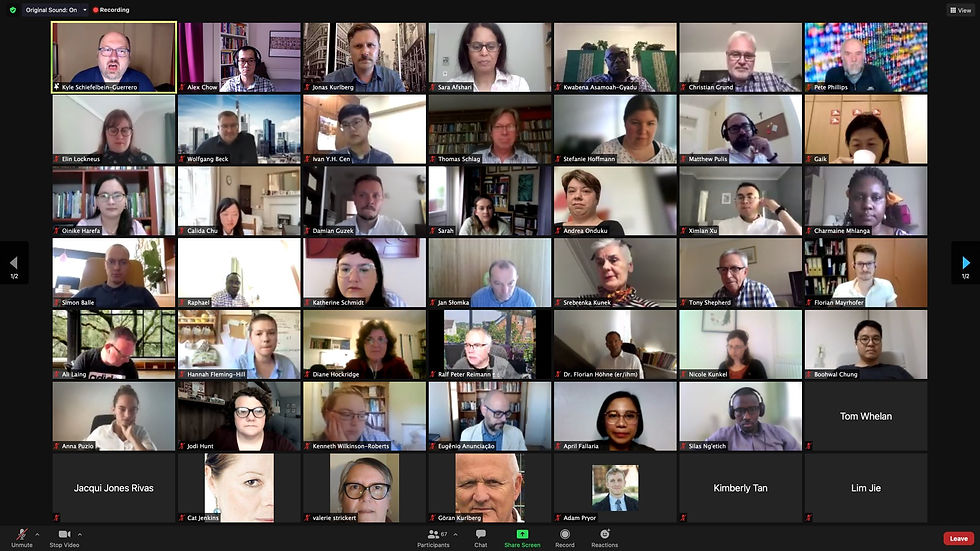Just what is going on?
- Pete Phillips

- Jul 15, 2021
- 4 min read
by Pete Phillips, Premier's Head of Digital Theology
This week sees the first ever annual conference of the Global Network for Digital Theology: #GoNeDigiTal2021 (follow this Twitter hashtag for more news).

For three days this week around 100 people will gather to discuss all things digital and theology - focussing especially on how digital disrupts theological reflection and education. We're trying to map across a huge number of time zones with contributors from New Zealand, South East Asia, Europe, sub-Saharan Africa, and the Americas (South and North). As such, we're focussing our meetings around 13.45-17:00 (British Summer Time). Yesterday, the first day, it was fantastic to see that the audience spanned most of the world.

The conference is academic and seeks to push the boundaries of how we think about digital. So, in one of the papers yesterday, Adam Pryor began to ask questions of whether digital is a different kind of thing to other technologies. Is digital a different dimension rather than just a different form of technology? That's a little hard to grasp but does match some other arguments in digital theology. So, in another paper, Katherine Schmidt was exploring the "Inevitable Hybridity" which digital technology is creating. She argues that by taking a mobile phone into worship, we (unintentionally) hybridise that space - we make it possible for the space to be both onsite and online because of the presence of the digital device. That seems to be like shifting the dimensions of the space. It doesn't mean that the space is automatically digital (we need to operate the tool to make this happen) but it does make it potentially digital.

It's a bit like Marshall McLuhan arguing that the "medium is the message", which basically means that the medium we use changes/alters/spins the message we are are trying to put across. Think of how live-streaming our services through YouTube/FacebookLive or other streaming services, emphasises the performance or theatre aspect of church services. We show what's happening up front. We focus on the liturgical actors (worship band, minister, preacher) and on particular backgrounds (stage, altar, communion table). And Church is theatre, in part. On the other hand, Zoom services tend to focus on the community which comes together to worship. We see people's faces (unless they choose not to share video which is fine - some people choose to sit on the back row in onsite worship), we hear their voices, we see their reactions on Zoom. What Zoom does is to emphasise Church as a gathering of people, a coming together ('episynagoge' in Hebrews 10) to worship God. We can still see the liturgical actors among the congregation and they can be spotlighted when they are reading, preaching, singing - but they come from amongst the rest of the congregation rather than exist onscreen separately from them. Indeed, another screen could show an altar, a reflection table, a cross - adding focuses for worship to the Zoom community. But still they are among us rather than creating a theatre presentation of them.

Digital Theology wants us to ask those sort of questions. Is digital so all pervasive, all changing, all affecting, that it is a new dimension? Does having a mobile phone with you necessarily change/hybridise the places you go into. And indeed does all technology do this. I think my response to this last question is actually that it doesn't. I mean, print was huge. It probably enabled the Reformation with Luther alone responsible for 300,000 copies of his tracts being produced. Print has changed the way we do communication and teaching and learning. Print has an ongoing (but sadly declining?) impact on the whole of our culture. But there are non-print cultures still and Walter One and others have argued that digital has brought with it a second focus on oral culture - with the power of stories and the spoken word replacing print again. One of my PhD students, Frida Mannerfelt explores the impact of the Gutenberg parenthesis in the preaching of Swedish preachers! In oral cultures, we quilt the Word into our preaching, whereas in print culture, we have tended to cite Scripture.
It's going to be a fascinating week.
You can find out more (and sign up for future news) about the Global Network here. We're a network of people across the globe exploring digital culture and its impact on theology and theology's impact on digitality. Some of our members are professors in universities or research students, some teach in theological colleges, many are pastors or evangelists in various churches across the world. We're especially interested in engaging more people from Global Majority cultures and backgrounds (whether presently resident in Global Majority countries or in Global North countries) in order to hear more diverse views on Digital Theology. So one of our papers today, presented by Terry Pouono and Stephen Garner will explore Pasifika' readings of "Tending to Digital Space" or "Teu la vā" focussing on the interpersonal relationships of which digital are just one part.

You'll also find all the papers which are being presented at the Conference at the same site. One of those, "The Time is Digital" by South African Methodist Minister Jacqui Rivers includes a video of Jacqui presenting the paper from her home church.

Premier and Spurgeons College are working closely with the Centre for Digital Theology to develop new courses training people in how to explore these kinds of questions. Join us!
MA in Digital Theology - next taster session - August 3rd, 7.30pm
Hybrid Church - Lockdown Learnings - available soon





Box ScoreThe United States Travis Shaw Face Mask, and the rest of the world, continue the transition back towards normalcy as the widespread availability and distribution of the COVID-19 vaccine helps to bring an end to the pandemic. Things took a big step in Milwaukee with the capacity of American Family Field returning to 100%, which the Brewers celebrated as e-Opening Day against the Colorado Rockies on Friday afternoon. Things started off as a good, old-fashioned pitcher duel, with Corbin Burnes and Jon Gray matches zeroes for the first several innings. Gray punched out 10 batters in 5. 0 innings, and Burnes didn allow a hit until the sixth innings, although it was Corbin that blinked first. Raimel Tapia…